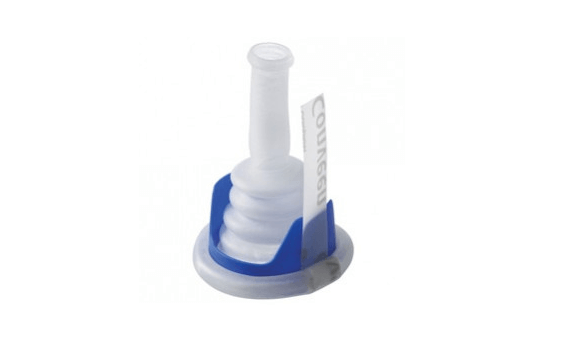Urinary catheters, like Uridome catheters, are normally used in elderly with urinary incontinence or retention, weakness or any other disease that may weaken their bladder. However, in some cases, Uridome Catheters are not recommended for the elderly.
This article lists all the Reasons Why Seniors Should Avoid Uridome Catheters so you can be mindful before considering an Uridome catheter for your loved one.
Here I also go into detail about the types of urinary catheters to note what makes Uridome catheter a special one, and the differences between an Uridome catheter and an indwelling one.
To answer these questions, let’s go to the very beginning, the catheter, its types and its uses.
Let’s start…
What Is A Catheter?
A catheter, or a urinary catheter, is a medical device with a flexible tube used to collect urine from the body into a bag, called a urine bag. It is used to drain the urinary bladder in situations where it cannot be emptied normally.
A catheter could be inserted into the body or worn externally. They could be permanent or temporary.
They come in different sizes and shapes, as well as types. Each type of urinary catheter is made for a person’s physical body’s needs.
Types Of Urinary Catheters
There are different kinds of urinary catheters. The use of each type depends on the urinary problem associated with each individual.
There are 3 main types;
1. Indwelling catheters
An indwelling urinary catheter is one that is inserted into the bladder of the patient.
It is also called Foley catheter, urethral catheter or suprapubic catheter. This type of catheter is suitable for use for both temporary and permanent use.
2. External catheters
The external catheter is also called a condom catheter, or Uridome catheter.
3. Short-term catheters
Short-term or intermittent catheter, it is worn only for a short while, like after surgery and does not anticipate the patient to have urinary incompetence for the long-term.
All the above types have their own advantages and disadvantages. They have benefits to a certain group of people and are rather, dangerous to others.
Though the Uridome catheter is very much recommendable, it is not recommended for seniors. Why? To explain that better, we need to understand the Uridome better.
So, what is an Uridome Catheter?
What Are Uridome Catheters?
Uridome catheters are just a group of several types of catheters, others being urethral, intermittent and suprapubic.
Uridome catheters, also known as external, condom or sheath catheters, are urinary catheters that are usually worn like a condom (hence the name “condom” catheter).
They are attached to a collection bag strapped to the user’s leg, where the urine drained from the bladder is stored. The condom catheter is used by males who suffer urinary incontinence, which is the inability to control their bladder.
One importance of the Uridome catheter, is its reduced risk of urinary infection (for some).
Generally speaking, since the Uridome catheters are external and do not involve a tube inserted into the urethra to drain urine, like the internal catheters, the risk of catheter-associated urinary tract infection (UTI) is reduced.
Types Of Uridome Catheters
The major differences between the various types of Uridome catheters are the shapes, materials and adhesives. They are classified below:
Based on materials
1. Latex catheters
They are made with latex and are cheaper than catheters of any other material.
Most of them come without an adhesive, so they usually have a one or two-sided strip attached. They are also relatively easier to use than the others. However, allergic reactions may stem from its use, so avoid if you have a latex allergy.
They also sometimes have a poor-quality seal, but this doesn’t seem to be much of an issue as not all males need to have a superlative seal
2. Silicone catheters
Catheters made with silicone typically come with an integrative adhesion, so they do not need an external strip.
They are more expensive than latex catheters. Still, They offer a more highly breathable, skin-friendly and odor-free experience in comparison.
The silicone catheters are also transparent, making it easier to see the urine. They are also very smooth, and some brands have an antibacterial coating applied.
The only disadvantage so far is the cost, else they are suitable for almost any situation and need.
3. Polyvinyl chloride (PVC) catheters
These catheters, made from synthetic plastic polymer polyvinyl chloride, are firm but also flexible enough for easy application.
They are often (but not always) latex-free, making them a good alternative for those with a latex allergy.
Critics are, however, of the opinion that the production, use and disposal of PVC materials create toxic chemicals.
4. Polyurethane (PU) catheters
These catheters are acclaimed to be the most comfortable of all because of the polyurethane material. They are usually thin, smooth and fit the male anatomy nicely.
They are also latex-free.
Based on shape
1. One-piece external catheter
The one-piece condom catheter consists of a single piece that is pulled on to wear the catheter. It is suitable for individuals who have a hard time wearing catheters with two or more pieces.
It could be made of any material.
2. Two-piece external catheter
This condom catheter is made up of two parts – a fixed one and a removable one.
The fixed part is typically worn over the penis, while the removable one is attached to the drainage tubing.
Based on adhesives
1. Non-adhesive Uridome catheter
The non-adhesive catheters do not contain their own adhesives. As such, they require skin glue, foam straps, single- or double-sided adhesive strips to attach them to the penis.
2. Self-adhesive Uridome catheter
These catheters contain an adhesive or a sticky film coating on their inner surface. They are attached by simply rolling up and pressing gently. Silicone catheters usually come with adhesives.
When Could You Consider Uridome Catheters?
As comfortable as it sounds to use an external catheter compared to an internal one, not all conditions warrant its use. They are required by those men whose bladder can drain itself, but only have problems controlling its release.
The conditions below encompass this description.
1. Unmanageable urinary frequency
It describes men who urinate more frequently than normal, and have problems controlling its release.
2. Incontinence
Urinary incontinency is the condition when a person losses control of their bladder, and thus can’t prevent the bladder from leaking out urine. Urinary incontinence may be a result of void reflexes from a spinal injury, or damage to the urethra sphincters from any surgery, like prostatectomy.
3. Dementia
With dementia, one should also consider Uridome catheters because urinary incontinence may develop at some stage of dementia.
4. Immobility
Men who are immobile cannot go to the bathroom all the time.
Some other condition that makes a person a good candidate for the use of Uridome catheters are:
- Those with recurrent urinary tract infection,
- Those with bladder spasms and /or bladder stones.
The Uridome catheter is perfect for the above group of people but should be avoided by seniors.
Here I list 10 reasons why seniors should avoid Uridone catheters.
10 Reasons Why Seniors Should Avoid Uridome Catheters
For the following reasons, seniors should avoid Uridome catheters.
1. Skin irritation, lesion or rashes
2. Leakage
3. Right size challenge
4. Difficulty in wearing
5. Catheter-associated infection
6. Allergies to skin
7. Dislodgement and Tugging catheter
8. Painful removal of the catheter
9. Urine backflow
10. Failed drainage into the urine bag
Now, let me explain those reasons one by one.
1. Skin Irritation, Lesion Or Rashes
One of the reasons seniors should avoid Uridome catheters is its risks, like skin irritation and lesion.
Although the Uridome catheter is external, it has associated risks to its use, of which are very dangerous to the seniors who use them. It is recorded that about 15-30% of patients come down with skin complications after using an external penile shaft.
Skin irritation, lesion or rashes, may be caused by perspiration of the skin within the condom catheter, pressure on the penis from the too-tight condom catheter, or gangrene of the penis.
2. Right Size Challenge
The rule of use of a catheter involves getting the correct size of sheath length and diameter. But with the elderly, it might be difficult.
Mobility challenges of the elderly can prevent them from getting the right sizes of condom/Uridome catheters.
Buying the wrong size of condom or Uridome catheters comes with its own disadvantage. A bigger Uridome catheter sheath length or diameter, will cause occasionally be dislodged, leading to undue leakage. And, a smaller Uridome catheter sheath length or diameter, can cause skin lesions from pressure placed on the skin, trying to fit it in.
3. Leakage
Though the Uridome catheter is leak-proof, leakage can still result when the wrong size of catheter is in use. When a catheter is too large, leakage will definitely occur. And leakage leads to urine spillage could cause skin irritations and rashes.
4. Difficulty In Wearing
There are so many guidelines on wearing an Uridome catheter, so it can get confusing to the seniors and elderly, especially those with memory problems like dementia patients—the guidelines of wearing focuses on preventing skin complications and infections.
5. Catheter-Associated Infection
The use of Uridome catheter can cause infections to the urinary tract, although the incidence of infection is greatly reduced as the Uridome catheter being external rather than invasive.
Urinary tract infection (UTI) in the elderly with changing immune system may cause them to develop signs like agitations, confusion and withdrawal.
Urinary tract infection in the elderly could lead to complications in their system, as if the UTI is left untreated, it may lead to permanent damage to their vital organs, sepsis and even death.
6. Allergies To Skin
Another very peculiar reason why a senior should avoid Uridome catheter is the allergic reactions to skin, which it may cause. Skins are different, and different skins react to different materials.
Like said earlier, Uridome catheters can be made from latex, silicon, Polyvinyl chloride or polyurethan.
Either of these materials may cause an allergic reaction to one of your elderly, and if not remedied as fast as possible, may result in other complications.
7. Dislodgement and Tugging Catheter
A review was done on the problems of external catheters, and questions were asked to all those who used the external catheter/Uridome catheter for a while before switching to an indwelling catheter.
One major setback which was reported by most users was the problem of dislodgement or tugging of the catheter. Pulling or tugging of the catheter could cause discomfort, it could be painful, and it could lead to leakage of the urine from the dislodged condom/Uridome catheters.
8. Painful removal of the catheter
Just as uneasily as it is to wear a catheter, so is its removal. Removal could be very painful, be it the right size or not, which explains why there have to be guidelines to its wearing and its removal.
But for older adults who live alone and have a vague knowledge of these guidelines, one will not expect them to easily remove and clean his/her catheter, and so may have to go through painful removal of the catheter.
To prevent an elder from going through such pain, it is advisable for elders to try another catheter rather than an Uridome catheter.
9. Urine Backflow
Urine backflow, is a common problem of Uridome or external catheters, and one way to remedy this is to always keep the urine bag below the level of the bladder. But this solution is easily forgotten by seniors, especially those with memory problems.
10. Failed Drainage Into The Urine Bag
When urine is no longer draining into the urine bag or collecting device, the patient gets leaks and skin irritation. This drainage problem is common with Uridome catheters used by older adults.
They don’t regularly empty their urine bag. And when they do, they completely empty it such that the vacuum left in it will prevent urine from draining through the tube again.
Alternative Options To Uridome Catheters
The Uridome catheter is not the only type of catheter. Like said before, other than the Uridome catheter, we have indwelling catheters and intermittent catheters. Depending on the medical condition, either of these two could serve as an alternative to the Uridome catheter.
It is best to receive advice from a health practitioner on things like this. Remember, my intention here is to share my experience but not to encourage you or your lovedone to or not to use an Uridome catheter. That should be the advice of your doctor.
Conclusion
Uridome catheter is a very good catheter device and advisable for use for those who can use it properly. But for the older adults and seniors who live alone and people with dementia, the reasons listed above will rightly tell you if to choose or avoid Uridome catheters.












The alternatives of an indwelling catheter or incontinence pants are considerably more expensive and carry greater risks of infection and irritation.
I speak from experience, one year so far.